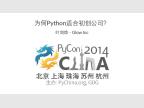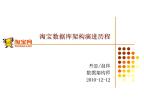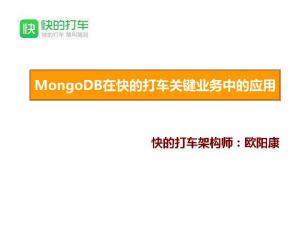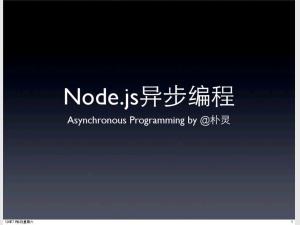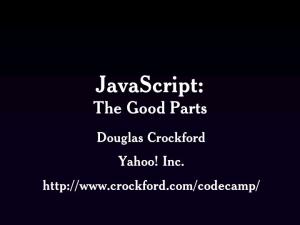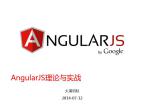第1页
MODERN
JAVASCRIPT
APPLICATIONS
Rivne 2013
Volodymyr Voityshyn
JAVASCRIPT
APPLICATIONS
Rivne 2013
Volodymyr Voityshyn
第2页
How to get well structured JavaScript code?
第4页
Client JavaScript Evolution
1. Client JavaScript resolved auxiliary tasks
2. Single Page Web Applications
3. Real time applications
1. Client JavaScript resolved auxiliary tasks
2. Single Page Web Applications
3. Real time applications
第5页
Contents
I. Some Useful Constructions II. What is wrong? III. JavaScript & OOP IV. Module Pattern V. Object Oriented Design Patterns VI. MV* Patterns via BackboneJS VII. Dependencies Management
I. Some Useful Constructions II. What is wrong? III. JavaScript & OOP IV. Module Pattern V. Object Oriented Design Patterns VI. MV* Patterns via BackboneJS VII. Dependencies Management
第6页
I. Some Useful Constructions
第7页
Closures
第8页
IIFE
第9页
Named Parameters
Must be documented
It’s useful for 4 and more parameters
Must be documented
It’s useful for 4 and more parameters
第10页
II. What is wrong?
第11页
Global Functions
Avoid global functions
Use instead:
Classes Modules
Avoid global functions
Use instead:
Classes Modules
第12页
Mixing JavaScript with HTML
▪ Place HTML and JavaScript in separated files
▪ Assign event handlers with JavaScript
▪ Place HTML and JavaScript in separated files
▪ Assign event handlers with JavaScript
第13页
Mixing JS & Server Code is Bad
ASP.NET MVC Razor
ASP.NET MVC Razor
第14页
Mixing JS & Server Code is Acceptable
ASP.NET MVC Razor
ASP.NET MVC Razor
第15页
III. JavaScript & OOP
第16页
Fact #1
Everything is an object
Everything is an object
第17页
… even primitives and functions
第18页
Creating an Object
第19页
Fact # 2
Object members can be added/deleted dynamically
Object members can be added/deleted dynamically
第20页
Defining Members
第21页
Creating an Object with JSON Notation
第22页
Deleting Members
第23页
Fact #3
All object members are public
All object members are public
第24页
Fact #4
Objects are hash tables
Objects are hash tables
第25页
Access to a Property with []
第26页
Fact #5
Inheritance is based on prototypes
Inheritance is based on prototypes
第27页
Inheritance
Obj ect
v ehicle + name + run()
bicycle + wheels
Sample_2_01
Obj ect
v ehicle + name + run()
bicycle + wheels
Sample_2_01
第28页
Fact #6
Functions can be considered as classes
Functions can be considered as classes
第29页
Pseudo Class
Object
Vehicle + name + run()
Object
Vehicle + name + run()
第30页
The “prototype” Property
Object
Vehicle + name + run()
Object
Vehicle + name + run()
第31页
Pseudo Class Inheritance
Obj ect
Vehicle + name + run()
Bicycle + wheels
Sample_2_02
Obj ect
Vehicle + name + run()
Bicycle + wheels
Sample_2_02
第32页
Inheritance: Practice Hints
Avoid a too long prototype chain
Avoid extending prototypes of built-in objects
Use framework functions for extending objects:
$.extend() _.extend() _.mixin()
Avoid a too long prototype chain
Avoid extending prototypes of built-in objects
Use framework functions for extending objects:
$.extend() _.extend() _.mixin()
第33页
Virtual Functions
第34页
Static Members
第35页
IV. Module Pattern
第36页
Module Pattern Intent
Provides both private and public encapsulation for classes
Provides both private and public encapsulation for classes
第37页
Module Example
▪ Closure is used for private state
▪ “Public” object is returned
▪ Created by IIFE
Sample_3_01_Module_Counter
▪ Closure is used for private state
▪ “Public” object is returned
▪ Created by IIFE
Sample_3_01_Module_Counter
第38页
Import Dependencies
第39页
Extending
Sample_3_02_Module_Strings
Sample_3_02_Module_Strings
第40页
Extending jQuery Module
第41页
Extending Underscore Module
第42页
Page Code Behind as Module
Page
(HTML + CSS)
Handle Events Read Data Put Data
Code Behind
(JavaScript Module)
Sample_3_04_PageCodeBehind_Module
Page
(HTML + CSS)
Handle Events Read Data Put Data
Code Behind
(JavaScript Module)
Sample_3_04_PageCodeBehind_Module
第43页
Advantages vs. Disadvantages
Advantages
Simple in development Possibility of using a page base class
Disadvantages
Becomes too large in case of a complex page Hard in automated testing Can’t be used with SPA
Advantages
Simple in development Possibility of using a page base class
Disadvantages
Becomes too large in case of a complex page Hard in automated testing Can’t be used with SPA
第44页
Class as Module
第45页
V. Object Oriented Design Patterns
第46页
V.1. Creational Patterns
“… help make a system independent of how its objects are
created, composed, and represented” (GoF)
“… help make a system independent of how its objects are
created, composed, and represented” (GoF)
第47页
Factory Pattern Intent
Provides an interface for creating families of related or dependent objects without specifying
their concrete classes.
(GoF)
Provides an interface for creating families of related or dependent objects without specifying
their concrete classes.
(GoF)
第48页
Classical Abstract Factory
AbstractComponentFactory - components + create(string)
ChComponentFactory IEComponentFactory
Calendar + render()
IECalendar + render()
ChCalendar + render()
Grid + render()
IEGrid + render()
ChGrid + render()
Sample_4_01_AbstractFactory_CrossBrowser_Component
AbstractComponentFactory - components + create(string)
ChComponentFactory IEComponentFactory
Calendar + render()
IECalendar + render()
ChCalendar + render()
Grid + render()
IEGrid + render()
ChGrid + render()
Sample_4_01_AbstractFactory_CrossBrowser_Component
第49页
Service Locator & IoC
Provides abstract interface for instantiating objects Resolves dependencies among objects Manages objects’ life cycle
Provides abstract interface for instantiating objects Resolves dependencies among objects Manages objects’ life cycle
第50页
Prototype Pattern Intent
Specify the kinds of objects to create using a prototypical instance, and create
new objects by copying this prototype.
(GoF)
Prototype
clone()
New Object
Specify the kinds of objects to create using a prototypical instance, and create
new objects by copying this prototype.
(GoF)
Prototype
clone()
New Object
第51页
Prototype by Native JavaScript
Object p
id, name
p1 p2
Object p
id, name
p1 p2
第52页
Prototype as a Shallow Copy
Object
p3
id, name
p4
id, name
p5
id, name
Object
p3
id, name
p4
id, name
p5
id, name
第53页
Prototype as a Deep Copy
Object
p6
id, name
p7
id, name
Object
p6
id, name
p7
id, name
第54页
Classical Prototype
第55页
Cloning DOM Elements
第56页
V.2. Structural Patterns
“… are concerned with how classes and objects are composed to form larger structures” (GoF)
“… are concerned with how classes and objects are composed to form larger structures” (GoF)
第57页
Adapter Pattern Intent
Convert the interface of a class into another interface clients expect
(GoF)
Client
Old Interface
Expected Interface
Convert the interface of a class into another interface clients expect
(GoF)
Client
Old Interface
Expected Interface
第58页
Adapting to Underscore Interface
第59页
Decorator Pattern Intent
Attach additional responsibilities to an object dynamically
(GoF)
Client
Decorator 2 Decorator 1
an Object
Attach additional responsibilities to an object dynamically
(GoF)
Client
Decorator 2 Decorator 1
an Object
第60页
Classical Decorator
第61页
Decorator and IIFE
第62页
Decorator with Closure
第63页
Façade Pattern Intent
Provide a unified interface to a set of interfaces in a subsystem. Facade defines a higher-level interface that
makes the subsystem easier to use.
(GoF)
Client
Façade
A Complex System
Provide a unified interface to a set of interfaces in a subsystem. Facade defines a higher-level interface that
makes the subsystem easier to use.
(GoF)
Client
Façade
A Complex System
第64页
Façade in jQuery
Client
$.ajax()
XMLHttpRequest
Client
$(“<tag>”)
document.createElement()
Client
$.ajax()
XMLHttpRequest
Client
$(“<tag>”)
document.createElement()
第65页
Façade: Important Consideration
Performance
Comfortable Interface
Performance
Comfortable Interface
第66页
V.3. Behavioral Patterns
“… are concerned with algorithms and the assignment of responsibilities among objects”
(GoF)
“… are concerned with algorithms and the assignment of responsibilities among objects”
(GoF)
第67页
Observer Pattern Intent
Define a one-to-many dependency between objects so that when one object changes state, all its dependents are notified and updated automatically.
(GoF)
Subject
Notify about changes
Observer 1 Observer 2 Observer 3
Define a one-to-many dependency between objects so that when one object changes state, all its dependents are notified and updated automatically.
(GoF)
Subject
Notify about changes
Observer 1 Observer 2 Observer 3
第68页
Publish/Subscribe
第69页
Publish/Subscribe & Backbone Event
第70页
Mediator Pattern Intent
Define an object that encapsulates how a set of objects interact. Mediator promotes loose coupling by keeping objects from referring to each other explicitly, and it lets you
vary their interaction independently.
(GoF)
Define an object that encapsulates how a set of objects interact. Mediator promotes loose coupling by keeping objects from referring to each other explicitly, and it lets you
vary their interaction independently.
(GoF)
第71页
Mediator as Event Buss
Module 1
Publishes an event
Module 2
Listens an event
Event Buss
Transfers an event from the publisher to the listeners
http://thejacklawson.com/Mediator.js/
Module 1
Publishes an event
Module 2
Listens an event
Event Buss
Transfers an event from the publisher to the listeners
http://thejacklawson.com/Mediator.js/
第72页
Mediator as Web Modules Manager
Web Module 1
Manage user’s interaction
Don’t know about each other
Everything a web module knows about the application
Web Module Context
Web Module 2
Web Module ↓
an independent part of GUI
Web Modules Manager
Manages a web module life cycle
Manages collaboration among modules
Nicholas Zakas: Scalable JavaScript Application Architecture
Web Module 1
Manage user’s interaction
Don’t know about each other
Everything a web module knows about the application
Web Module Context
Web Module 2
Web Module ↓
an independent part of GUI
Web Modules Manager
Manages a web module life cycle
Manages collaboration among modules
Nicholas Zakas: Scalable JavaScript Application Architecture
第73页
Strategy Pattern Intent
Define a family of algorithms, encapsulate each one, and make them interchangeable.
(GoF)
Define a family of algorithms, encapsulate each one, and make them interchangeable.
(GoF)
第74页
Sorting Algorithms as Strategy
第75页
VI. MV* Patterns via BackboneJS
第76页
Model – View – Controller
View
Model
Controller
Main goal - separate view and data
View
Model
Controller
Main goal - separate view and data
第77页
Top JavaScript MVC Frameworks
Backbone.js Angular.js Ember.js Knockout.js
Backbone.js Angular.js Ember.js Knockout.js
第78页
Backbone Object Types
Events Model Collection View Router
Events Model Collection View Router
第79页
Backbone.js Typical Stack
Backbone.js
jQuery
Require.js Underscore.js
Backbone.js
jQuery
Require.js Underscore.js
第80页
Backbone Advantages
Simple in usage Defines major types of an application objects Gets much freedom for application structure Easily extensible Gets on well with other frameworks
Simple in usage Defines major types of an application objects Gets much freedom for application structure Easily extensible Gets on well with other frameworks
第81页
VII. Dependencies Management
第82页
What is a bad design?
Inflexibility Fragility Solidity
Inflexibility Fragility Solidity
第83页
Coupling
A measure of how much a module relies on other modules
A measure of how much a module relies on other modules
第84页
Cohesion
A measure of how closely related the members of a module are to the other members of the same module
Low High
A measure of how closely related the members of a module are to the other members of the same module
Low High
第85页
What is a good design?
Flexible Robust Reusable
Flexible Robust Reusable
第86页
What’s a main problem?
第87页
What is a key to success?
Manage dependencies!
Manage dependencies!
第88页
Dependency Inversion Principle
A. High level modules should not depend upon low level modules. Both should depend upon abstractions.
B. Abstractions should not depend upon details. Details should depend upon abstractions.
(Robert C. Martin)
The Dependency Inversion Principle (by Robert C. Martin)
A. High level modules should not depend upon low level modules. Both should depend upon abstractions.
B. Abstractions should not depend upon details. Details should depend upon abstractions.
(Robert C. Martin)
The Dependency Inversion Principle (by Robert C. Martin)
第89页
Dependency Inversion Formula
X Y
X IY Y
X Y
X IY Y
第90页
Design Quality Criteria
How easily could your code be covered by unit tests?
Could web modules be used independently?
How easily could your code be covered by unit tests?
Could web modules be used independently?
第91页
Class Dependencies
Passive Injection
Constructor Method Field
Active Injection
Service Locator
Passive Injection
Constructor Method Field
Active Injection
Service Locator
第92页
Module Dependencies
Asynchronous Module Definition (AMD)
define(id?, dependencies?, factory)
https://github.com/amdjs/amdjs-api/wiki/AMD
Asynchronous Module Definition (AMD)
define(id?, dependencies?, factory)
https://github.com/amdjs/amdjs-api/wiki/AMD
第93页
RequireJS Module Sample
第94页
Web Modules Dependencies (1)
第95页
Web Modules Dependencies (2)
View 1
View 1
View 1
View 1
View 1
Root View
View 2
Models & Collections
View 1
View 1
View 1
View 1
View 1
Root View
View 2
Models & Collections
第96页
For further reading…
1. JavaScript Good Parts 2. JavaScript Garden 3. Leaning JavaScript Design Patterns (by Addy Osmani) 4. JavaScript Module Pattern: In-Depth (by Ben Cherry) 5. Scalable JavaScript Application Architecture (by Nicholas
Zakas) 6. Journey Through The JavaScript MVC Jungle (by Addy
Osmani) 7. Developing Backbone.js Applications (by Addy Osmani) 8. superhero.js
1. JavaScript Good Parts 2. JavaScript Garden 3. Leaning JavaScript Design Patterns (by Addy Osmani) 4. JavaScript Module Pattern: In-Depth (by Ben Cherry) 5. Scalable JavaScript Application Architecture (by Nicholas
Zakas) 6. Journey Through The JavaScript MVC Jungle (by Addy
Osmani) 7. Developing Backbone.js Applications (by Addy Osmani) 8. superhero.js


